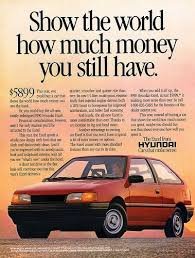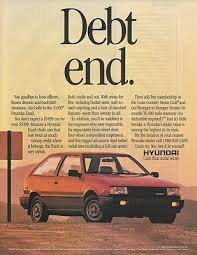How Hyundai Successfully Entered the U.S. Automobile Market
Hyundai was founded by Chung Ju-yang who was born to a poor farming family in North Korea. At the age of 18, he set off to Seoul to find a better life. After laboring in construction and railway jobs, he landed a job as a deliveryman in a rice store where he impressed the owner with his business skills. At 22, Chung became the owner of the rice store. However, he was forced to close it by Japanese occupation forces in 1939. After the liberation of Korea in WWII, Chung started an automobile repair business and did some work on U.S. Army trucks. Within three years, his business had 70 employees.
After the liberation of Korea in 1946, Chung started Hyundai Engineering and Construction, because he knew his country would need to rebuild its infrastructure. It won major government contracts to build building roads, dams, and highways. It also won contracts with the U.S. military for buildings and facilities. Despite a lack of experience in shipbuilding, he persuaded a customer to build a ship for tens of millions of dollars. Today Hyundai Heavy Industries is the largest shipbuilder in the world.
Source: Hyundai Motor Group
“We succeeded because our people devoted their enterprising spirits. They used the force of the minds. Conviction creates indomitable efforts. This is the key to miracles… Man’s potential is limitless.”
The company’s first entry into the U.S. market came in 1986 with the Hyundai Excel. The car came in either a three- or four-door sedan version with a price range of $4,995 to $6,445. That was about half the price of most new cars; a four-door sedan from General Motors Pontiac cost $12,400. But having a low price was not a guarantee of success. Americans were skeptical of foreign cars with low prices. A few years earlier, a Yugoslavian company introduced the Yugo that sold for around $4,000. However, it was slow, crawling to 60 miles per hour (mph) in 14 seconds, and it had major mechanical issues. Car and Driver magazine dubbed it “the worst car in history.” Many Americans called it the “NoGo.”
A major problem was name recognition: at the time in the 1980s, few people in the U.S. had ever heard of Hyundai. In marketing terms, its brand recognition was zero. In addition, Americans didn’t know how to pronounce the company name. One critic said it sounded like “high and dry,” which is in the American vernacular means being in a desperate situation with little resources. Certainly, this wasn’t good for an automobile company.
Hyundai’s first move into the U.S. was to hire Backer & Spielvogel Advertising where I started my marketing career. At the agency, we set out to establish Hyundai as a global manufacturing company that could be trusted to produce a good car. Research found that Americans would first need to be sold on Hyundai before they would consider buying its low-priced automobiles. The agency created television commercials, billboards, and print advertisements that introduced Hyundai as an industrial leader. One showed Hyundai-built ships conquering rough ocean waters. Another presented towering buildings being built with Hyundai equipment. The advertising ran for three or four months with little mention of the fact that Hyundai also produced automobiles.
After the American public became aware of Hyundai and its industrial prowess, the agency launched advertisements introducing the cars. Then after three months or so, we started to advertise the Hyundai Excel as a new, smart choice with the tagline “Cars that make sense.” The advertising was noteworthy and memorable. One television commercial featured a man driving home from the Hyundai dealer with two cars. He’d drive about 100 yards in one car. Stop. And scuttle back to the second car to drive it forward 100 yards. This was meant to demonstrate that you could by two Hyundai’s for the price of a single American car.
1986 Advertisements for Hyundai
The strategy worked: the Excel was the fastest selling new car launch ever. In the first year, Hyundai sold over 100,000 cars. It also signed on many American businesspeople who wanted to open Hyundai automobile sales and service dealerships. In 2021, Hyundai’s 820 dealerships sold more than 738,000 vehicles. Nearly half were built at the Hyundai factory in Alabama. Hyundai’s U.S. operations contribute more than 94,000 private sector jobs with a total impact of $7 billion to the U.S. economy.
Lessons from Hyundai’s Success:
Establish credibility
Americans won’t consider buying products or services from a company they don’t know and don’t trust. Hyundai needed to establish itself in U.S. market as a strong and capable manufacturing company. It needed a strong brand.
Make a strong entrance
You can’t go into an American market timidly. Hyundai got people’s attention and interest with smart marketing and a good story. If you can’t afford to reach the entire country, focus on making a strong entrance in one region or city and then expanding to other markets.
Hire local experts
The U.S. market is complex and challenging. Consumers and business buyers are skeptical and demanding. Therefore, it’s wise to hire business consultants and marketing experts with experience and local knowledge.
Success is attainable
International companies that successfully enter the U.S. experience many years of sustained growth and profitability. Why? Because along with the difficulties and challenges, companies learn, grow, and develop muscles that ultimately attract top talent.
NOTE: This case study was excerpted from Make It In America; How International Companies and Entrepreneurs Can Successfully Enter and Scale in U.S. Markets by Matthew Lee Sawyer, published by Wiley in 2022




